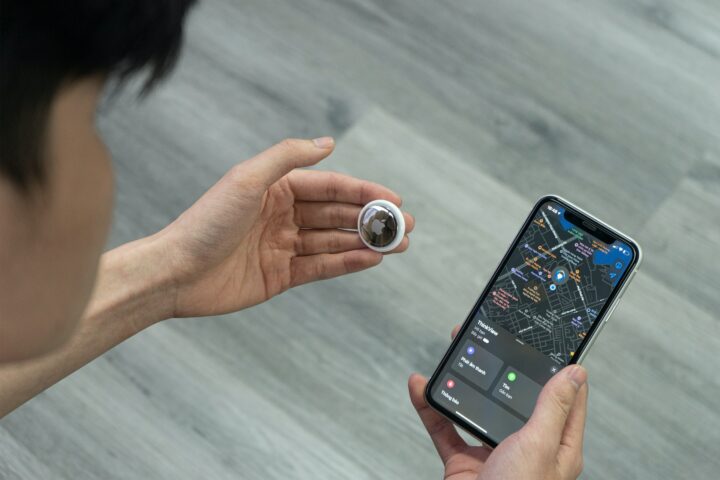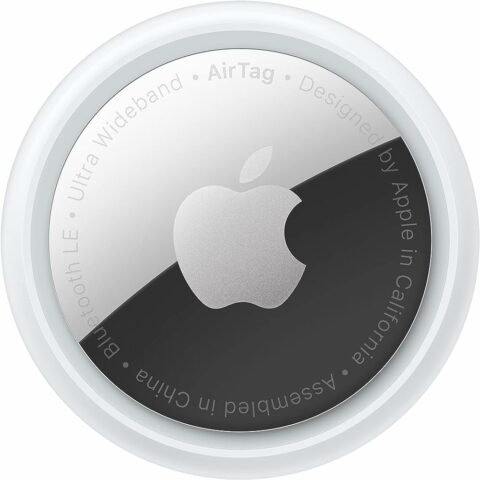Misplacing keys, wallets, and other belongings is a common problem many of us face. However, Apple’s AirTags offer a solution for the forgetful. These Bluetooth trackers are affordable at $29* each or $99* for a pack of four. They seamlessly integrate with iOS devices, providing a tracking experience beyond the ordinary. In this Apple AirTags review, we will explore how they redefine the tracking landscape by offering elegance, precision, and magic to those needing a reliable solution for everyday forgetfulness.
What will you see here?
Overall Review of Apple AirTags
Apple AirTags stand as a testament to Apple's innovation in simplifying our daily lives. Setting them apart from competitors like Tile, these $29 trackers offer a sleek design and unparalleled ease of use for iOS users. The initial setup is as effortless as pulling a plastic tab, and within seconds, your AirTag is ready to be named and identified within the Find My app.
The magic begins with the Precision Finding feature, utilizing Bluetooth and ultra-wideband technology. When within 20 feet, the AirTag guides you with on-screen directions and haptic feedback, ensuring you never play a game of hide-and-seek with your belongings again. The directional arrow, a perk for iPhone 11 or higher users, adds an extra layer of convenience, making tracking a breeze.
The AirTag's robust Bluetooth connection surpasses that of its competitors, with a range that extends far beyond the 30-foot limitation of Tiles. Whether nestled in a backpack or wedged between couch cushions, the AirTag's piping sound, though quieter than Tile Mate, proves effective within 20 feet. The reliability of the Bluetooth connection becomes evident, addressing a common pain point experienced by users of other trackers.
Privacy takes center stage in the AirTag experience. With end-to-end encrypted Bluetooth connections, the AirTag ensures that location and identity remain confidential, even in a network of strangers' Apple phones. Apple's responsiveness to privacy concerns is evident in the alert system, which notifies users if an unknown AirTag seems to be shadowing them.
However, a few nuances surface in the AirTag experience. While the sleek design adds an aesthetic touch, the need for additional accessories, like key fobs, incurs extra costs. The AirTag's performance wanes in remote areas, relying on the presence of iPhones for accurate location updates.
Specifications
| Category | Specification |
|---|---|
| Size and Weight | Diameter: 1.26 inches (31.9 mm), Height: 0.31 inch (8.0 mm), Weight: 0.39 ounce (11 grams) |
| Splash, Water, and Dust Resistance | Rated IP67 (maximum depth of 1 meter up to 30 minutes) under IEC standard 60529 |
| Connectivity | Bluetooth for proximity finding, Apple-designed U1 chip for Ultra Wideband, NFC tap for Lost Mode |
| Speaker | Built-in speaker |
| Battery | User-replaceable CR2032 coin cell battery |
| Sensor | Accelerometer |
| Accessibility | Find My app compatible with VoiceOver, Invert Colors, Larger Text, braille displays |
| System Requirements and Compatibility | Apple ID, iPhone and iPod touch with iOS 14.5 or later, iPad with iPadOS 14.5 or later |
Price and availability
The Apple AirTag is competitively priced at $29* for a single unit. Providing an affordable solution for users looking to track and locate their belongings. For those interested in a bundled option, a pack of four AirTags is available at $99*, offering a discounted rate for multiple trackers.
Apple AirTags offers flexible pricing, with individual units at $29.99*. Multipacks include a 2-pack for $54.99* and a 4-pack for $99.99*. Engraving is complimentary, and AppleCare+ costs $12.99* for 2 years. Accessories like the Leather Loop and Polyurethane Loop are available. Special editions maintain standard pricing. Trade-in discounts and financing options are also offered.
In addition to the base cost of the AirTags, users may consider purchasing optional accessories to enhance their usage. Apple offers key fobs and loops in silicone or leather, starting at $29*. It’s worth noting that third-party brands like Belkin also provide officially licensed AirTag holders, often at a slightly lower cost. The availability of these accessories adds a level of customization and convenience to the overall AirTag experience.
While the AirTag itself is attractively priced, users should keep in mind the potential additional cost of accessories, which can contribute to the overall investment in this tracking solution. As Apple continues to foster a third-party ecosystem. Users can explore various options to suit their preferences and budget when it comes to accessorizing their AirTags.
Design
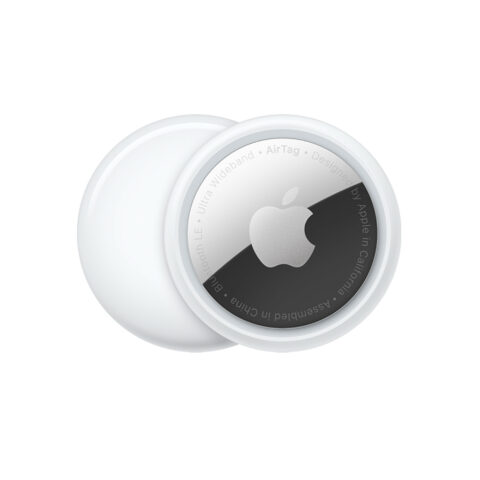
The Apple AirTag boasts a sleek and compact design, making it a discreet and easily integrated tracking solution. Each AirTag is slightly larger than a quarter, measuring 1.26 x 1.26 x 0.31 inches (3.19 x 3.19 x 0.8 cm), and weighs a mere 0.4 ounces (11g). Its design is simple yet sophisticated, featuring a stainless steel disc with a removable plastic cover that secures the CR2032 battery powering the AirTag.
The minimalist design allows for versatility in how users choose to incorporate the AirTag into their daily lives. With no built-in clip or tag, the AirTag can be conveniently tucked into a wallet, slipped into a bag, or placed in a coat pocket for those who prefer to attach it to keys or other items. Optional key fobs and loops are available in both leather and silicone. The AirTag is also eligible for Apple’s free engraving service, allowing users to add personalized text, numbers, or emojis to the smooth plastic cover, aiding in easy identification when multiple AirTags are in use.
Notably, the AirTag has an IP67 rating, indicating its resistance to water for up to 30 minutes. This design feature ensures durability and makes the AirTag suitable for various environments, including accidental exposure to water. However, it’s essential to consider that the shiny sides of the AirTag may be susceptible to scratches. Users should handle them accordingly to maintain their aesthetic appeal. Overall, the Apple AirTag’s design emphasizes both functionality and aesthetic appeal. This aligns with Apple’s commitment to delivering products seamlessly blending into users’ lifestyles.
Performance

The Apple AirTag excels in performance, offering a seamless and user-friendly experience for tracking items in various scenarios. Setting up the AirTag is a breeze, taking only seconds to pair with an iPhone. Once paired, users can assign a name and emoji for easy identification. Making it intuitive to manage multiple AirTags within the Find My app under the “Items” tab.
The Precision Finding feature, available when the AirTag is within approximately 20 feet, enables users to locate their tagged items with accuracy. The feature provides on-screen directions and haptic feedback on the iPhone, guiding users toward the AirTag’s location. Additionally, the app allows users to make the AirTag emit a sound. Which is helpful when the tracker is inside a bag or purse.
The real-world performance of the AirTag is notable, especially when tracking items in different environments. AirTag leverages Bluetooth signals and the Find My network to provide frequent and accurate location updates with other iPhone users in crowded locations or areas. This is demonstrated when tracking a partner’s movements, such as golfing and working in the city, where the AirTag consistently updates the location throughout the day.
However, the performance may vary in remote or less populated areas, as the AirTag relies on nearby iPhones to relay location data. In scenarios where there are no iPhones around. For example, the AirTag’s ability to provide accurate location information diminishes when hiking in the wilderness. This highlights the dependency on the Find My network for optimal performance.
Privacy is a paramount consideration in the AirTag’s design, with location data and history not stored on the AirTag itself. When communicating with other iPhones, all information is anonymous and encrypted, ensuring that only the user can access the location data.
Battery Life
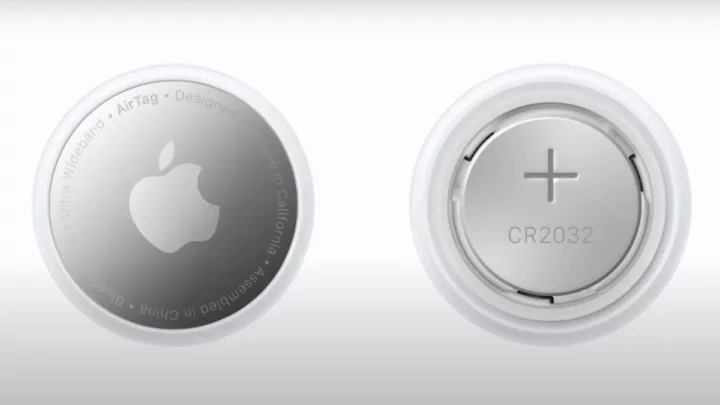
The Apple AirTag is designed to provide long-lasting battery life. It comes equipped with a replaceable CR2032 coin-cell battery. The claimed battery life for the AirTag is over a year, which makes it a reliable and low-maintenance tracking device. However, Apple has optimized the AirTag to minimize power consumption, ensuring that it can effectively track items for an extended period before needing a battery replacement.
Replacing the battery is a straightforward process. Users can twist off the back cover of the AirTag to access the battery compartment and replace the CR2032 battery. This design allows users to easily maintain the device’s functionality without requiring specialized tools or professional assistance.
Keep in mind that actual battery life may depend on factors such as the frequency of tracking updates—distance from other Apple devices, and overall usage. Nevertheless, the AirTag’s focus on efficiency and the ability to replace the battery contributes to its practicality as a long-term tracking solution for everyday items.
Privacy
Apple’s AirTags offer a convenient solution for tracking personal items, but their functionality raises privacy concerns. The AirTag utilizes Bluetooth signals and the Find My network, relying on the proximity of iOS devices to determine the location of the tracker. While this method is effective, it poses potential privacy risks.
One notable concern is the possibility of unwanted tracking. If someone slips an AirTag into your belongings, it can discreetly monitor your movements. Although Apple has implemented measures to prevent misuse, such as notifying users of unfamiliar AirTags following them, the risk persists. The three-day silent period, initially intended to deter stalking, has been adjusted to a random duration between 8 and 24 hours, but it remains a potential issue.
The AirTag’s reliance on the Find My Network introduces another consideration. The tracker operates optimally in densely populated areas with numerous iOS devices. In rural or less-populated regions, its effectiveness diminishes. Unlike true GPS trackers, which use their cellular connection for location data, AirTags depend on the proximity of other Apple devices.
Apple has ensured encrypted communication and anonymity within the Find My network to address privacy concerns. However, users must remain vigilant, especially when an AirTag could be used for unwanted tracking. Android users lack a dedicated app for detecting stray AirTags, creating a potential blind spot in monitoring and protecting against unauthorized tracking.
As technology evolves, users must understand the privacy implications of tracking devices like AirTags. Apple’s commitment to user privacy is evident in its features, but users should remain mindful of potential misuse and take precautions to safeguard their personal information.
Features
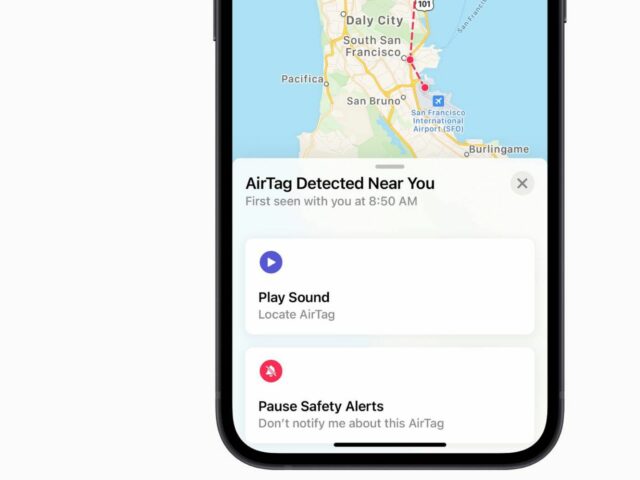
Apple AirTags utilize innovative technology to efficiently track your belongings, providing a seamless and user-friendly experience. Regarding tracking, AirTags stands out with its Precision Finding feature and integration with the extensive Find My network.
Precision Finding Feature
Upon unboxing your AirTag, the setup process is swift and straightforward. A short beep signals its activation, and placing it near your iPhone prompts automatic detection. Naming the AirTag is customizable, allowing for easy identification in the Find My app. AirTags are notably smaller than traditional key fobs, resembling a sleek disc that fits effortlessly into pockets or attaches to accessories.
The Precision Finding feature allows you to locate the AirTag within a range of approximately 20 feet. This feature provides on-screen directions and haptic feedback, guiding you to the precise location of your tagged item. The tracker emits a distinctive sound, aiding in locating it within proximity.
Bluetooth and Ultra-Wideband (UWB) Technology
AirTags leverage Bluetooth signals to establish a connection with nearby iPhones. This connection is notably more reliable than competitors like Tile, ensuring consistent performance. The UWB directional protocol, available on iPhone 11 and higher models, enhances the tracking experience by displaying directional arrows in the Find My app, making it easier to locate your item accurately.
The AirTag’s Bluetooth connection is robust and dependable, surpassing the intermittent performance of other trackers. This reliability contributes to the effectiveness of the Precision Finding feature, enhancing the overall tracking experience.
Find My Network Integration
When your AirTag is beyond the Bluetooth range, it taps into the Find My network. This network comprises millions of Apple devices worldwide, creating a vast and efficient system for tracking lost items. Other iPhones in proximity anonymously share location data, allowing you to locate your AirTag even when it’s far from your device.
It’s crucial to note that the AirTag isn’t a true GPS tracker and relies on being within 30 feet of an iPhone to share its location. While ideal for urban areas with many iPhone users, its effectiveness diminishes in less populated regions.
How does Apple AirTag work?
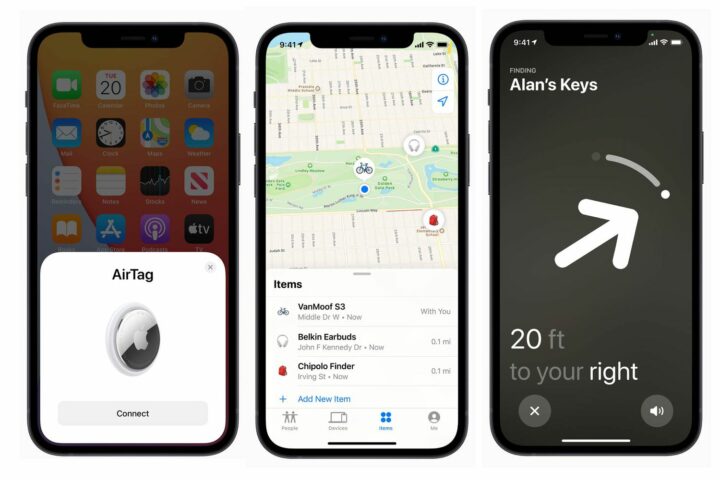
The Apple AirTag is a compact Bluetooth tracker designed to help users locate frequently misplaced items. Upon setup, which is remarkably easy and involves pairing the AirTag with an iPhone, the device emits a short beep and seamlessly integrates with the Apple ecosystem. The AirTag utilizes Bluetooth signals to communicate with the user’s iPhone and other nearby Apple devices within the extensive Find My network.
With its Precision Finding feature, the AirTag assists in locating items within a short range, guiding users toward the missing object through on-screen directions and haptic feedback. When outside the Bluetooth range, the AirTag relies on the broader Find My network, pinging off other iPhones to send location data back to the user. This functionality proves particularly effective in crowded locations, making AirTags a valuable tool for tracking belongings in various scenarios, whether within the confines of one’s home or when venturing into the world.
Are Apple AirTags safe?
Yes, Apple AirTags are designed with safety features. They use Bluetooth technology to help locate lost items through the Find My app. Privacy measures are in place to prevent unauthorized tracking, and audible alerts on the AirTag ensure users are aware of its presence. However, users should be mindful of potential misuse and follow safety guidelines for responsible use.
Conclusion
Apple AirTags elevate the tracking experience and exemplify Apple’s knack for combining aesthetics with functionality. The precision in finding, reliability, and privacy features make AirTags a standout choice for iOS users looking to streamline their daily lives. Despite some limitations in rural settings, the AirTag’s affordable pricing at $29*, coupled with a battery life lasting over a year, positions it as an indispensable tool for those prone to misplacing their essentials. Whether in a bustling city or on a journey, Apple AirTags offers a reliable and stylish solution to the perennial problem of misplaced items.
Read More:
- Do you know Apple AirTag can precisely find your lost items as well as your lost child!
- Are Airtags Waterproof? A Deep Dive into Apple’s Tracking Device!!
- Apple AirTag vs. Tile Pro- Which tracker should you grab?
- AirTag vs Tile – Which Tracker Offers Best Safety For Your Things?
- All you need to know about iOS 14.6 – What’s new to consider?
Apple AirTags Makes losing things less Annoying!Â
-
Performance
-
Design
-
Features
-
Acuuracy
Summary
Apple AirTags revolutionize item tracking by seamlessly integrating with your Apple devices. Designed for simplicity and efficiency, these compact trackers connect to the Find My app, enabling precise location monitoring. Whether it’s keys, bags, or any cherished possession, AirTags make it easy to keep them in sight. With a sleek design and advanced technology, they enhance your daily life by providing peace of mind and convenience. Embrace the future of tracking with Apple AirTags, ensuring that your valuables are always within reach in the fast-paced world of modern living.


